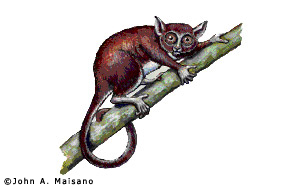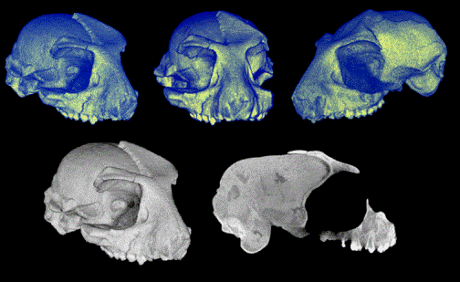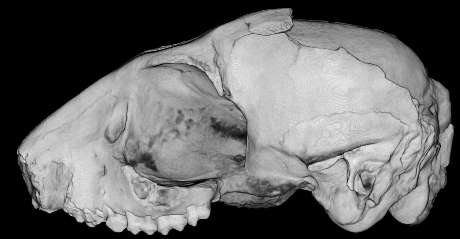Speaking of Primate Fossil Finds in Texas
Posted by: Craig Woolheater on April 6th, 2007
Earlier in the week, I posted here on Cryptomundo about the recent primate fossil finds here in Texas at New Texas Primate Species Found!
Last year, at the Bigfoot in Texas? exhibit, which was a joint collaboration of the Texas Bigfoot Research Center (now Conservancy) and the University of Texas San Antonio Institute of Texan Cultures, we exhibited a fossil primate skull from Texas.
The Texas Natural Science Center’s Texas Memorial Museum loaned the skull of the cute little fellow below for our exhibit.
It was displayed in a case alongside the Grover Krantz Gigantopithecus skull recreation, a gorilla skull and a human skull for size comparison.

Rooneyia viejaensis
Early PrimateSkull
TMM 40688-7
Vieja Formation, Oligocene
Presidio County, TexasRooneyia viejaensis is an omomyid, a member of a prosimian primate lineage that dates back approximately 55 million years. Like other early primates, Rooneyia was small. It was about the size of the modern tarsier, which inhabits the forests of Indonesia and the southern Philippines; and the galago, which inhabits the forests of Africa. Only a single specimen of Rooneyia has been discovered, and only the skull was preserved. Without the rest of the skeleton, it is difficult to be certain how it made its living, but like most other small primates it was probably arboreal, spending its life in the trees.
Primates are very rare in the fossil record. The tiny specimen that is buried at the Dino Pit is 35 million years old and among the most complete and best preserved primate skulls ever discovered in North America. Based on the size of its orbits (eye-sockets), Rooneyia was probably active during the daylight hours. Rooneyia has broad, flattened cusps on its teeth, which may indicate a diet that was rich in fruit. One of the unique features of this specimen is that some of the bones surrounding the brain had weathered away to reveal what is referred to as a natural “endocast”. An endocast is a replica of the brain that it is formed by sediments that fill the space that was occupied by the brain in the living animal. In animals with large brains, the skull records much of the detail of the brain’s surface, much like the shell of a walnut or a pecan nut. The infilling of sediment, now turned to rock, takes on the shape of the brain.
Dr. John A. Wilson, who is the founder of the Vertebrate Paleontology Laboratory of the Texas Natural Science Center, discovered this specimen in 1964. Dr. Wilson has now spent more than 60 years looking for fossils all across Texas. Although Rooneyia is a tiny fossil, it was the find of a lifetime for Dr. Wilson.Texas Memorial Museum

The skull of Rooneyia viejaensis, among the most complete and best preserved primate skulls ever discovered in North America
Source: University of Texas at Austin, Department of Geological Sciences

Rooneyia viejaensis is a late Eocene primate from West Texas. These reconstructions permit studies of the internal and external morphology of the skull with unprecedented detail and accuracy. (Top row) Pseudocolored 3D reconstruction of 100 0.5 mm CT slices, side, front and side views. Sample is 50 mm long. (Bottom left) Grayscale 3D reconstruction. (Bottom right) Single 100-micron CT slice through the mid-section of the skull
Source: University of Texas at Austin, Department of Geological Sciences
Check out the DigiMorph of the skull here: Rooneyia viejaensis

About Craig Woolheater
Co-founder of Cryptomundo in 2005.
I have appeared in or contributed to the following TV programs, documentaries and films:
OLN's Mysterious Encounters: "Caddo Critter", Southern Fried Bigfoot, Travel Channel's Weird Travels: "Bigfoot", History Channel's MonsterQuest: "Swamp Stalker", The Wild Man of the Navidad, Destination America's Monsters and Mysteries in America: Texas Terror - Lake Worth Monster, Animal Planet's Finding Bigfoot: Return to Boggy Creek and Beast of the Bayou.








